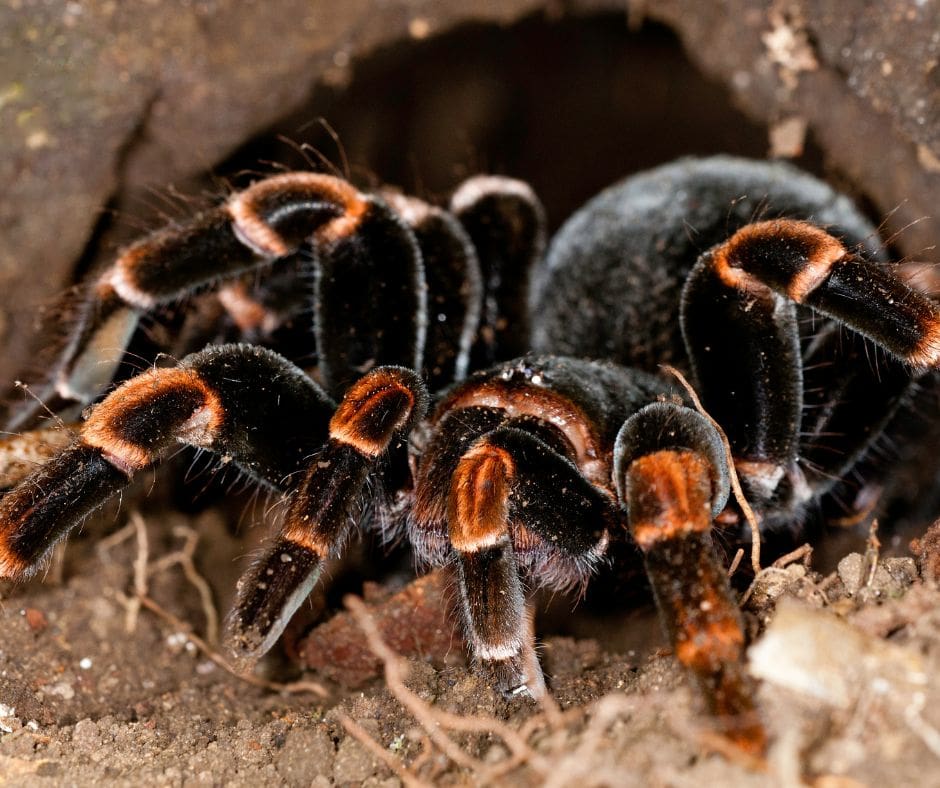The orange-kneed tarantula, a striking arachnid native to Costa Rica, is a fascinating subject that blends the allure of exotic wildlife with the intrigue of ecological balance. This species, known scientifically as Brachypelma smithi, stands out with its vibrant coloration and significant size, making it a notable presence in the Costa Rican landscape.
One of the most distinctive features of the orange-kneed tarantula is, unsurprisingly, its bright orange markings on the knees, which contrast sharply against its otherwise dark body. These colors are more than just for show; they play a crucial role in the spider’s interactions with both predators and potential mates. The vivid hues can serve as a warning to would-be predators, signaling the tarantula’s venomous nature.
The size of these tarantulas is also noteworthy. They can grow to a leg span of up to six inches, which is quite substantial for a spider. This size, coupled with their robust build, makes them one of the larger species within their habitat. Despite their intimidating appearance, they are known to be relatively docile towards humans, although they can defend themselves effectively when threatened.
In terms of habitat, the orange-kneed tarantula prefers dry forest environments and can often be found in burrows, which they line with silk. These burrows not only provide shelter but also serve as strategic points for ambushing prey. Their diet mainly consists of insects, but they can also take down larger prey like small lizards or rodents.
The reproductive habits of these tarantulas are also of interest. The male, after reaching maturity, sets out in search of a female to mate with. This journey can be perilous, as the male risks being cannibalized by the female post-mating. If successful, however, the female will lay eggs that she guards diligently until they hatch.
Finally, it’s worth noting the conservation status of the orange-kneed tarantula. While not currently listed as endangered, they face threats from habitat loss and the pet trade. Costa Rica’s efforts in conservation and environmental protection play a crucial role in safeguarding the future of this remarkable species.
The orange-kneed tarantula exemplifies the diverse and unique wildlife found in Costa Rica. Its presence adds to the rich biodiversity of the region and offers a unique glimpse into the complex web of life that thrives in this part of the world.
FAQ’s
Q: Are orange-kneed tarantulas dangerous to humans?**
A: Generally, orange-kneed tarantulas are not considered dangerous to humans. Their venom is potent for their small prey but typically results in no more than mild irritation or allergic reactions in humans. However, it’s always wise to respect their space and avoid handling them, as they can bite if they feel threatened.
Q: How long do orange-kneed tarantulas live?**
A: The lifespan of orange-kneed tarantulas can be quite long, especially for females. Females can live up to 20-25 years, while males have a shorter lifespan, typically around 5-10 years. This difference is primarily due to the risks males face during mating and their post-mating lifecycle.
Q: What do orange-kneed tarantulas eat?**
A: These tarantulas are carnivorous and primarily feed on insects such as crickets, beetles, and other small arthropods. They have also been known to eat small vertebrates like lizards or rodents, depending on their size and opportunity.
Q: How do orange-kneed tarantulas reproduce?**
A: Reproduction in orange-kneed tarantulas involves a risky process for the male, who seeks out a female and performs a courtship dance to avoid being mistaken for prey. If successful in mating, the female lays eggs in a silk cocoon and guards them until they hatch.
Q: Where can orange-kneed tarantulas be found in Costa Rica?**
A: They are typically found in the dry forest regions of Costa Rica. These tarantulas prefer habitats with ample hiding spots and a climate that supports their burrowing lifestyle.
Q: How do orange-kneed tarantulas contribute to the ecosystem?**
A: As predators, they play a crucial role in controlling the population of insects and other small animals, contributing to the ecological balance. Their burrows also help in aerating the soil.






